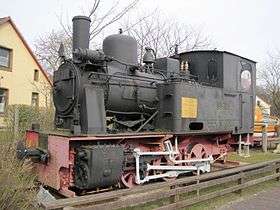DRG Class 99.21
| DRG Class 99.21 | |
|---|---|
 99 211 | |
| Number(s) | 99 211 |
| Quantity | 1 |
| Manufacturer | Henschel & Sohn |
| Year(s) of manufacture | 1929 |
| Retired | 1960 |
| Wheel arrangement | 0-6-0T |
| Axle arrangement | C n2t |
| Type | K 33.6 |
| Track gauge | 1,000 mm (3 ft 3 3⁄8 in) |
| Length over buffers | 6,400 mm (21 ft 0 in) |
| Height | 3,200 mm (10 ft 6 in) |
| Overall wheelbase | 2,000 mm (6 ft 6 3⁄4 in) |
| Service weight | 18.3 tonnes (18.0 long tons; 20.2 short tons) |
| Adhesive weight | 18.3 tonnes (18.0 long tons; 20.2 short tons) |
| Axle load | 6.1 tonnes (6.0 long tons; 6.7 short tons) |
| Top speed | 30 km/h (19 mph) |
| Indicated Power | 105 kW (143 PS; 141 hp) |
| Driving wheel diameter | 800 mm (2 ft 7 1⁄2 in) |
| Valve gear | Walschaerts (Heusinger) |
| No. of cylinders | Two |
| Cylinder bore | 310 mm (12 3⁄16 in) |
| Piston stroke | 400 mm (15 3⁄4 in) |
| Boiler Overpressure | 14 bar (1.40 MPa; 203 psi) |
| No. of heating tubes | 90 |
| Heating tube length | 2,550 mm (8 ft 4 1⁄2 in) |
| Grate area | 0.60 m2 (6.5 sq ft) |
| Evaporative heating area | 29.6 m2 (319 sq ft) |
| Water capacity | 1.8 m3 (64 cu ft) or 1,800 litres (400 imp gal; 480 US gal) |
| Fuel | Coal: 600 kg (1,300 lb) |
| Parking brake | Counterweight brake |
| Locomotive brakes | Steam brake |
The only example of the German DRG Class 99.21 steam locomotive was built for the Wangerooge Island Railway on Wangerooge, one of the German-owned Friesian islands in the North Sea.
History
For hauling eight-wheeled passenger coaches a more powerful locomotive was needed. After the procurement of diesel locomotives in 1958 she remained for a time as a reserve engine. She carried number 99 211.
Today the locomotive is restored and is displayed as a monument on Wangerooge.
Technical Details
The inner frame of the locomotive was also used as a water tank. She was designed as a wet steam locomotive. The boiler had two shell rings and 90 heating tubes. The drive was achieved via a Walschaerts valve gear driving the third axle. The wheels on the centre axle were made without flanges to improve curve running.
The engine could hold 0.6 tonnes of coal in side tanks either side of the boiler, and 1.8 m2 of water in the frame and in an attachment to the coal bunker. The engine was first equipped with electrical lighting in 1953.
Literature
- Werning, Malte (1999). Wangerooge: Die Inselbahn und ihre Geschichte. Gülzow: Lokrundschau Verlag. ISBN 3-931647-09-9.